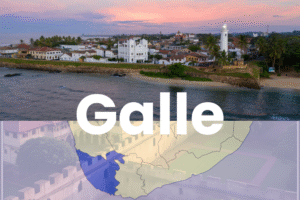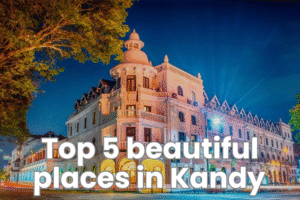Discover the historical charm and coastal beauty of Galle, a gem on Sri Lanka’s southern coast. From UNESCO heritage sites to pristine beaches, this comprehensive guide covers everything you need to plan an unforgettable journey to one of Sri Lanka’s most enchanting destinations.
Introduction
Nestled on the southwestern coast of Sri Lanka, Galle is a captivating blend of colonial history, stunning landscapes, and rich cultural heritage. This ancient trading port, with its well-preserved Dutch-colonial architecture and picturesque beaches, offers travelers a perfect balance of historical exploration and seaside relaxation. Whether you’re a history buff, beach lover, or cultural enthusiast, Galle promises an enriching experience that will leave you with lasting memories.
In this guide, we’ll explore the top 10 attractions that make Galle a must-visit destination on your Sri Lankan itinerary. From the iconic Galle Fort to hidden beaches and serene lakes, these attractions showcase the diverse experiences this coastal paradise has to offer.
1. Galle Fort: A Step Back in Time

Why Visit: A UNESCO World Heritage Site that perfectly captures Sri Lanka’s colonial past.
Galle Fort stands as the crown jewel of the region, a testament to Sri Lanka’s complex colonial history. Built by the Portuguese in the late 16th century and later fortified by the Dutch, this architectural marvel seamlessly blends European structural elements with South Asian traditions.
As you wander through the fort’s cobblestone streets, you’ll be transported back in time. The well-preserved colonial buildings house boutique shops, art galleries, and cafés that add a contemporary touch to this historical setting. Don’t miss walking along the massive ramparts that encircle the fort—especially at sunset, when the golden light bathes the ancient walls and offers breathtaking views of the Indian Ocean stretching to the horizon.
The fort isn’t just a tourist attraction; it’s a living heritage site where locals continue to live and work, creating a unique atmosphere where past and present coexist harmoniously.
Visitor Tip: Early morning or late afternoon visits provide the most comfortable temperatures for exploring the fort on foot.
2. Dutch Reformed Church: Colonial Spiritual Heritage

Why Visit: One of the oldest Protestant churches in Sri Lanka with remarkable architectural details.
Within the protective walls of Galle Fort lies the Dutch Reformed Church, a spiritual landmark dating back to 1755. This historical church offers visitors a peaceful respite from the bustling streets outside and provides fascinating insights into the colonial era’s religious practices.
Step inside to admire the church’s exquisite interior features, including an elaborately carved wooden pulpit, antique pipe organ, and ornate tombstones embedded in the floor. The surrounding cemetery contains gravestones with inscriptions in Dutch, telling silent stories of European settlers who made Sri Lanka their home centuries ago.
The church’s simple yet elegant architecture, with its distinctive gabled roof and columns, makes it a perfect example of Dutch colonial religious buildings. Even if you’re not particularly religious, the church’s historical significance and serene atmosphere make it worth a visit.
Visitor Tip: Remember this is an active place of worship; dress modestly and maintain a respectful demeanor during your visit.
3. Galle Lighthouse: Coastal Beacon with a View

Why Visit: Sri Lanka’s oldest lighthouse with spectacular coastal vistas.
Standing proudly on the southeastern tip of Galle Fort, the iconic white Galle Lighthouse serves as both a historical landmark and a photographic centerpiece. As the oldest lighthouse in Sri Lanka, it carries centuries of maritime history while continuing to guide ships along the coast.
While the lighthouse itself isn’t open to the public, its picturesque setting on the fort’s ramparts makes it one of the most photographed spots in Galle. The surrounding area buzzes with life, offering a delightful array of cafés and boutique shops housed in restored colonial buildings.
Take your time exploring this corner of the fort, perhaps pausing for an ice-cold king coconut or a cup of Ceylon tea while watching the powerful waves crash against the rocks below. The constant sea breeze and rhythmic sound of waves create a soothing atmosphere perfect for unwinding after a day of sightseeing.
Visitor Tip: Visit in the early morning to capture stunning photographs without crowds and enjoy the softer light.
4. National Maritime Museum: Nautical Heritage Preserved

Why Visit: Fascinating exhibits on Sri Lanka’s maritime history and archaeological treasures.
For those interested in delving deeper into the region’s seafaring past, the National Maritime Museum provides an educational window into Galle’s importance as a historic port. Located within the Galle Fort in a former Dutch warehouse, this museum houses a collection of artifacts that tell the story of Sri Lanka’s nautical traditions.
The museum showcases maritime artifacts, scale models of ships, maps, and items recovered from shipwrecks around the Sri Lankan coast. Exhibits detail how Galle served as a crucial stopping point for trade ships traveling between East and West for centuries. You’ll learn about the various colonial powers that controlled the port and how they influenced local maritime practices.
Though relatively small, the museum offers valuable insights into how the sea shaped the history, economy, and culture of this island nation.
Visitor Tip: Combine this visit with other attractions within the fort to maximize your time in the area.
5. Galle International Stadium: Cricket with a View

Why Visit: One of the world’s most scenic cricket grounds with the fort and ocean as its backdrop.
Even if you’re not a cricket enthusiast, the Galle International Stadium is worth visiting for its extraordinary setting alone. Positioned between the majestic Galle Fort and the sparkling Indian Ocean, this cricket ground is widely regarded as one of the most picturesque sporting venues in the world.
During match days, the stadium comes alive with the cheers of passionate fans, colorful flags, and the excitement of international cricket. But even when games aren’t in progress, you can still appreciate the stadium’s unique location and imagine the thrilling matches that have taken place here over the years.
Cricket holds an almost religious status in Sri Lanka, and experiencing this iconic ground offers insight into an important aspect of local culture. From certain vantage points, you can capture photographs that include the pitch, the fort walls, and the azure ocean—a combination that makes this stadium truly one-of-a-kind.
Visitor Tip: Check the Sri Lanka Cricket website before your visit to see if any matches coincide with your trip—watching a game here is an unforgettable experience.
6. Galle Main Market: Authentic Local Experience

Why Visit: A vibrant hub of local commerce and culture just outside the fort.
For an authentic glimpse into everyday Sri Lankan life, a visit to the bustling Galle Main Market is essential. Located just beyond the fort area, this colorful marketplace brims with local energy and offers a sensory feast for visitors.
As you navigate through the lively stalls, you’ll encounter a vivid array of fresh tropical fruits, vegetables, aromatic spices, textiles, and handicrafts. The market air is filled with a medley of scents—fresh herbs, exotic spices, and tangy fruits—creating an olfactory experience that complements the visual spectacle.
Engaging with the friendly vendors provides opportunities to learn about local ingredients and perhaps pick up tips on Sri Lankan cooking. Many sellers are happy to offer samples and share stories, making your market visit both educational and delicious.
This is also an excellent place to purchase spices like Ceylon cinnamon, cloves, and cardamom as souvenirs—just remember to bargain politely, as it’s part of the market culture.
Visitor Tip: Visit in the morning when the market is most active and the produce is freshest.
7. Jungle Beach: Secluded Coastal Paradise

Why Visit: A hidden beach offering tranquility away from the tourist crowds.
When the time comes to escape the historical explorations and embrace Sri Lanka’s famous coastal beauty, Jungle Beach offers the perfect retreat. Tucked away in a secluded cove just a short tuk-tuk ride from Galle Fort, this hidden gem lives up to its name with its unique combination of lush foliage and pristine shoreline.
Unlike the more developed beaches in the area, Jungle Beach retains a natural, unspoiled charm. The small crescent of golden sand is framed by verdant jungle that comes almost to the water’s edge, creating a Robinson Crusoe-like atmosphere. The crystal-clear waters offer excellent opportunities for swimming and snorkeling, with vibrant marine life visible just a few meters from shore.
The beach’s somewhat hidden location means it rarely gets crowded, allowing visitors to enjoy the tranquil environment and the soothing sound of waves without disturbance.
Visitor Tip: Bring your own refreshments as facilities are limited, and consider wearing water shoes as the sand can get hot during midday.
8. Unawatuna Beach: Coastal Entertainment Hub

Why Visit: A popular beach destination with something for everyone—from relaxation to water sports and nightlife.
Just a few kilometers from Galle lies Unawatuna Beach, one of Sri Lanka’s most beloved coastal destinations. With its golden crescent of sand and turquoise waters protected by a coral reef, it’s easy to understand why this beach has earned international acclaim.
Unawatuna offers a perfect balance of relaxation and activity. Sun-seekers can lounge on beach chairs under the shade of palm trees, while more adventurous travelers can enjoy snorkeling, diving, or even surfing during certain seasons. The coral-rich waters host an abundance of marine life, making underwater exploration particularly rewarding.
As the day progresses, the beach transforms from a sun-soaked paradise to a vibrant nightlife destination. Beachfront restaurants and bars serve fresh seafood caught that very day, exotic cocktails, and both local and international cuisine. Many venues feature live music and fire shows after sunset, creating a festive atmosphere under the stars.
Visitor Tip: The beach can get crowded during peak season; arrive early to secure a good spot and be cautious of strong currents in certain areas.
9. Koggala Lake: Serene Island Exploration

Why Visit: A tranquil lake dotted with islands, rich in biodiversity and cultural experiences.
For a change of pace from the coastal attractions, Koggala Lake offers a refreshing alternative just a short drive from Galle. This expansive freshwater lagoon, fringed with mangroves and dotted with small islands, provides a peaceful setting for nature exploration and cultural immersion.
A boat trip on Koggala Lake reveals a world of natural wonders and local traditions. As your vessel glides through the calm waters, keep your eyes peeled for varied wildlife—from majestic water monitors to colorful kingfishers and other bird species that call this ecosystem home.
The lake tour typically includes stops at several islands, each offering unique experiences. You might visit a cinnamon plantation to learn about traditional spice cultivation, observe the ancient art of stilt fishing (though nowadays often demonstrated for tourists), or explore Madol Duwa island, famous for being the setting of a renowned Sinhalese novel.
Interacting with local fishermen and islanders offers insights into rural Sri Lankan life that few tourists experience, making Koggala Lake a destination that combines natural beauty with authentic cultural encounters.
Visitor Tip: Early morning boat rides offer the best wildlife viewing opportunities and beautiful misty views across the lake.
10. Japanese Peace Pagoda: Tranquility and Panoramic Views

Why Visit: A serene Buddhist monument offering spectacular coastal views and spiritual ambiance.
Perched majestically atop Rumassala Hill, the gleaming white Japanese Peace Pagoda serves as both a spiritual sanctuary and an exceptional viewpoint. Built in 2005 as part of a worldwide project by Japanese Buddhist monks to promote peace, this impressive stupa stands as a beacon of tranquility overlooking the Indian Ocean.
The journey to the pagoda is part of the experience—a winding path through lush jungle vegetation leads visitors uphill, with the sounds of nature providing a soothing soundtrack. Once at the top, you’re rewarded with breathtaking panoramic views stretching across Galle’s coastline and the vast blue expanse beyond.
The pagoda’s pristine white dome creates a striking contrast against both the azure sky and the emerald greenery surrounding it. Walking around the circular structure, you can observe intricate Buddha statues in various poses representing different life stages of Gautama Buddha.
Sunset is a particularly magical time to visit, as the fading light bathes the white stupa in golden hues while casting long shadows across the landscape. The peaceful atmosphere is occasionally punctuated by the gentle chanting of monks and soft ringing of bells, enhancing the spiritual ambiance.
Visitor Tip: Dress modestly as this is a religious site, and bring water for the uphill walk—especially during the heat of the day.
Practical Travel Information for Visiting Galle
Best Time to Visit
Galle enjoys a tropical climate year-round, but the best time to visit is during the dry season from December to March when rainfall is minimal and temperatures average a pleasant 27-30°C (80-86°F). The shoulder seasons of April-May and September-November can offer fewer crowds while still providing good weather, though with occasional showers.
Getting Around
- Tuk-tuks: The most convenient way to explore Galle and its surroundings. Always agree on a price before departing.
- Bicycles: Available for rent and perfect for exploring the fort area and nearby attractions at a leisurely pace.
- Walking: The fort area is best explored on foot, with most attractions within walking distance of each other.
- Private car/driver: Recommended for day trips to more distant attractions or for comfort during the hot season.
Where to Stay
Galle offers accommodation options for every budget:
- Luxury: Historic boutique hotels within Galle Fort, often in beautifully restored colonial buildings
- Mid-range: Comfortable guesthouses and hotels both within the fort and in the new town
- Budget: Hostels and simple guesthouses, primarily in the new town or in nearby Unawatuna
Local Cuisine to Try
While exploring Galle, don’t miss these culinary experiences:
- Fresh seafood: Being a coastal town, Galle offers exceptional seafood dishes
- Kottu Roti: A popular Sri Lankan street food made with chopped flatbread, vegetables, and meat or seafood
- Hoppers: Bowl-shaped pancakes often served with curry or topped with an egg
- King coconut: A refreshing natural drink perfect for hot days
Conclusion
Galle stands as a perfect microcosm of Sri Lanka’s diverse appeal—where colonial history, natural beauty, and vibrant culture converge to create an unforgettable destination. From the historic ramparts of Galle Fort to the serene waters of Koggala Lake and the golden shores of Unawatuna, each attraction offers a unique window into this coastal paradise.
Whether you’re spending just a day in Galle as part of a larger Sri Lankan adventure or settling in for a week of exploration, these ten attractions provide a comprehensive experience of what makes this region special. Take your time to absorb the laid-back atmosphere, engage with the friendly locals, and create memories that will last long after your journey ends.
Galle’s charm lies not just in its individual attractions but in the harmonious way they blend together—historical sites overlooking pristine beaches, spiritual monuments rising from lush jungles, and traditional practices continuing alongside modern developments. This balance makes Galle not simply a destination to check off your travel list but a place to experience deeply and remember fondly.
Have you visited any of these attractions in Galle? Share your experiences in the comments below!



